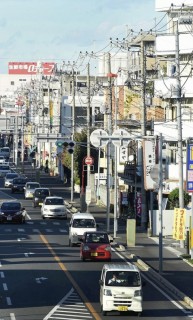Loading
Search
▼ Only 1% of power lines put below ground due to cost, local objections
- Category:Other

THE JAPAN NEWS
Nearly 30 years have passed since the government embarked on the process known as undergrounding — replacing overhead electrical power lines with underground cables for aesthetic and safety purposes — but only 1 percent of the nation’s cables are now underground.
In contrast, about 70,000 new utility poles continue to be set up around the country each year.
With the 2020 Tokyo Olympics and Paralympics looming in the distance, some Diet members recently moved to present a bill prohibiting the construction of utility poles, but progress stalled when the House of Representatives was dissolved on Dec. 21 for a general election.
Underground lines also cost many times more than overhead lines, a major obstacle to putting the national power grid underground.
Massive cost differentials
“Even if we stop putting up new utility poles, it’ll take at least 300 years to get rid of them all at this rate,” sighed Susumu Takada, a visiting professor at Ritsumeikan University who also serves as director general of the nongovernmental body Support Network for Utility Pole-Free Community Redevelopment.
In 1986, the government drafted a plan to replace utility poles with underground cables for a number of reasons, including more attractive landscapes.
The central government and relevant local bodies kicked off the massive undertaking, bearing the costs to dig tunnels and lay cables underground while utility firms and other relevant companies covered the removal of overhead lines.
According to the Land, Infrastructure, Transport and Tourism Ministry, however, only 7 percent of roads in Tokyo and 5 percent of those in Osaka and Nagoya are utility pole-free, excluding farm roads and such. This is a far cry from the 100 percent seen in overseas cities such as London and Paris.
Why the slow progress? Because laying power lines underground is expensive.
Digging a one-kilometer tunnel costs more than ¥300 million, and at least another ¥150 million is needed to lay the wires. The total cost is significantly higher than the ¥10 million to ¥20 million needed to erect utility poles.
“If construction costs surge, electricity bills would need to be raised,” said an official in charge of undergrounding at the Federation of Electric Power Companies of Japan.
Overhead wires on the rise
Underground lines are also said to be essential to improving public safety during natural disasters. Utility poles brought down by earthquakes, typhoons and other severe natural events could damage and destroy buildings, and impede rescue and fire-fighting efforts and the transportation of relief goods — all actual problems encountered during past disasters.
When the 1995 Great Hanshin Earthquake struck, for example, about 8,100 utility poles collapsed. The 2011 Great East Japan Earthquake brought down about 56,000. Rescue operations were hampered as a result in both cases.
A survey conducted by the Board of Audit this year discovered there were 47 locations across eight prefectures, including Kanagawa and Hyogo, where utility poles and overhead lines remained on roads to be used in times of disaster even though at least five years had passed since the construction of underground tunnels there. The ministry says progress is being impeded mostly because local residents oppose laying cables underground.
The number of utility poles continues to soar at a rate of roughly 70,000 a year, currently standing at about 35.22 million nationwide. An official at Tokyo Electric Power Co. said, “Each time a new community is created in a suburban area, we need a large number of utility poles for power transmission.”
Eyesore for foreign tourists
The Liberal Democratic Party had planned to submit a bill to the last extraordinary Diet session to prohibit, in principle, the setting up of new utility poles on the grounds that cities with a web of overhead lines would be an “eyesore for foreign tourists.” The legislator-sponsored bill was abandoned because of the lower house dissolution, but the LDP intends to introduce the bill to an ordinary Diet session next year.
The land and infrastructure ministry, along with other government organizations, has started looking into the feasibility of a construction method where cables are directly laid underground, eschewing the conventional approach requiring a tunnel. Officials project the alternative method would cut construction costs by about half.
“Utility poles on narrow roads threaten the safety of the elderly and disabled in their everyday lives, let alone at times of disaster,” said Prof. Haruo Ishida at Tsukuba University, a member of a private-sector group that supports overhead to underground power conversion.
“We have to do away with the mentality that undergrounding is only a matter of aesthetics, and waste no time in addressing the problem,” he warned.
- December 2, 2014
- Comment (0)
- Trackback(0)

